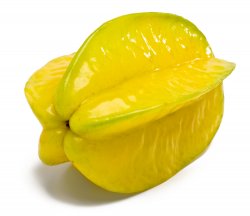This was another fruit that I was really excited to try out! It has a really unique appearance—with five distinct edges in its’ skin, so when you slice it the pieces of fruit are in the shape of stars! When I first tasted it, I was very surprised to find out that the star fruit has a very high water content. I found that it had an indistinguishable taste and crunchy texture, and even after tasting many pieces, I could not figure out what the taste was! At first, I did not like it at all. I found it strange and I was pretty disappointed; but after eating a few more pieces, I found myself starting to like the strange taste, most likely because it was like nothing I had tasted before. I also passed the pieces of fruit to my roommates and got mixed reviews; some of them really liked it while the rest felt the same way I did.
After this experience with the star fruit, I think I would most likely use it as a decorative element from now on, but I encourage you to try it yourself and see what you think!
What it is:
A fruit with origins from Sri Lanka, star fruit is grown on the Carambola tree that is now found in subtropical regions of the Americas, Asia and Australian. Western cultures tend to use the star as a garnish for other dishes because of its’ unique appearance.
What you should look for:
When buying a star fruit, pick a fruit that is yellow in colour (this indicates that it is more ripe). When the edges of the star fruit have dark brown edges, this is another indicator of ripeness, but be careful because brown spots all over the fruit are an indicator of over-ripeness!
If the fruit is green, allow it to ripen at room temperature until it turns yellow.
Nutrition Fact: 1 cup of raw star fruit contains 41 calories, 4 g of fibre and 76% of your recommended dietary allowance of vitamin C, plus many other nutrients!

